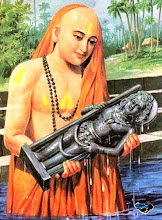Angaara Akshate
Discussion about the significance of angAra - akShate worn on the forehead by pious Madhwa Brahmins. When it should be worn and when not worn? How should it be prepared?
स्वाति... :-
As I know angara akshate is the symbol of gadhe. It has prana devara sannidhi. It is put while you eat naivadya. Without angara akshate you are not suppose to serve the brahmanas. Only angara is supposed to be put on the day of ekadashi.
akshate is prepared by drying banana peal and burning it which turns black (then it is powdered) and turmeric is added to the powder the coal which is used while u do the pooja that is dhoopaangara for god is used as angara later.
if any mistakes please correct
Dilip :-
yathA pAdOdakaM puNyaM nirmAlyaM chAnulEpanam |
naivEdyaM dhUpaShEshaM cha ArArtishcha tathA hareH || 99
Acharya in kRushnAmRuta mahArNava quotes the above verse. Here it is mentioned that one should take “dhUpaShEsha”. This is the piece of coal after dhUpArati. This dhUpaShEsha is angAra.
There is no directions/quotations from Acharya for the form of akShate that we use today. It is basically based on sampradAya and can be interpreted any way we want (gadhe of Bheema or kaDagOlu of Krishna, etc)
It is believed that this practice was started by Shri Narahari teertharu as a symbol for mAdhvas. It was popularized through yakShagAna ballets which he fostered.
Bala :-
More about angAra akShate
Source: Sumadhwaseva
1. angAra akShate is the symbol of gadhe; it has prANa dEvara sannidhi; it is applied before taking teertha prasAda
2. Only angAra is supposed to be put on the day of EkAdashi
3. akShate is prepared by drying banana peal and burning it, which turns black (then it is powdered) and then mixed with turmeric paste.
4. The coal which is used while you do the pooja that is dhUpAngara for God is used as angAra.
5. Normally one must NOT remove angAra akShate once it is applied in a day. However, due to weather conditions - sweating / rain - sometimes we may have to wash our face, then we have to apply it AGAIN.
6. The preparation of angAra akShate ensures and involves "nitya-pooja". In akShate we have the sannidhAna of SriLakshmi devi whereas in angAra, we have the sannidhAna of Sriman Narayana.
Here is a youtube video link for preparation of angAra akShate
http://www.youtube.com/watch?v=ab_DD2tSbhU
Yogi :-
I feel we shouldn't give (rather create) importance to something which doesn't have significance.
Kundalini, the effulgent current of consciousness, flows from tip of spine to sahasrAra above the head, passing through six chakras - nAbhi, hRudaya, bhuja, kaNTha, bhrUmadhya and then to sahasrAra. So in these respective places we apply gopi chandana. The 3 nAmas indicate 3 yogic nADis - iLa, suShumna & pingaLa.
So, it is also said in the Vedas to apply Urdhva-puNDra (vertical) nAmas.
About what we call angAra-akShate there is no mention in Vedas and shAstras. Still we have given importance to it.
Creating overheads is also not-so-good for spirituality. e.g., Sri JagannAtha dAsaru had a practice of streepAka nEma according to which he wouldn't eat anything prepared by women. After he became haridAsa he simply gave up all those non-significant overheads.
shiMshumAra :-
The other context of angAra aXate is also tied with the gandha lEpana. The order of applying should be gandha, followed by angAra, then aXate. Gandha (yellow/white), angAra (black) and aXathe (red) signify the sannidhAna of Sree, Bhoo and Durga deviyaru.
The other differentiation factor is the changes in sampradAya across Mutts, regions, families about the position of angAra and aXate. A few keep a gap between angAra & aXate, others make sure aXate is right on the angAra at the lower portion,
with a tail of angAra visible below the aXate. Most have the dot (Circle) of aXate
right below the end of angAra.
For more information on Urdhwa puNDra, angAra/aXate, nAma dhAraNe,
please refer a book by the name "nAma dhAraNe" by Vidwan Sri Vadirajacharya Karnam. He has been writing the content in instalments in Sri Sudha (Kannada) as well since 8-10 weeks.
The book "nAma dhAraNe" published by VMMP and sponsored by Madhwa Yuva Parishat, was released on the auspicious occasion of Sudha Mangala at Tirukoilur by
Sri Satyatma Theertharu.
GM :-
In my understanding, madhwa brahmins always go with PRAMANA's. Unless you have some PRAMANA written by Acharya or his followers, normally we don't follow that procedure, but how we are following the ANGARA and AKSHATHE without any PRAMANA ?
I heard for VEEBHUTHI and KUNKUMA there is a PRAMANA, it is told by one of the sudha pandith from Vidyapeeta [Bangalore].

5 comments:
Please mention details of angaraka. Is it mere a piece of wooden charcoal? Plz clarify.
Where can we buy angara as well as akshate online?
Only angara should be worne on ekadashi.......does it mean no gopichanda a ??? please clarify.
Online in websites like Madhwakart have akshate. At a local matha, one can acquire angAra (if not already owned).
Angara is the coal which is offered to Vishnu during dhUpa Arathi in dEvarapUje (often it is what has been used for cooking in maDi).
On EkAdashi, gopichandana must be worn, and on top of that angAra. Always gopichandana must be worn.
Hope this helps. shrI rAma
Very vivdly explained. Please tell us how to put angara and akshate straightly as many are unaware of which finger to use fir angara and akshate.
Post a Comment